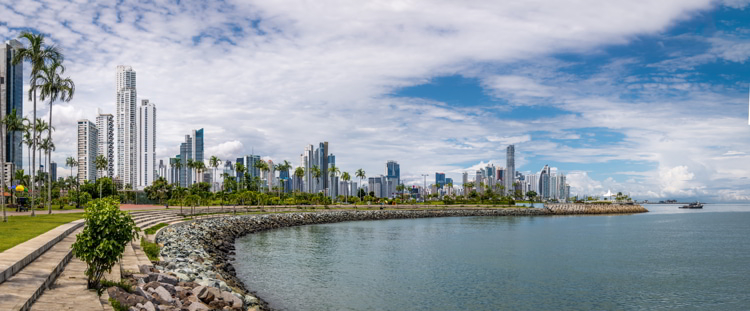There are things we take for granted living in the United States, Canada, and other developed countries… Things that tourists and new expats never think about when traveling to countries where infrastructure is less developed and building codes less sophisticated than what they may be used to…
The streets and sidewalks may not be paved with gold in North America, but they are paved… and generally they have even surfaces. This cannot be said for many of the walkways here in Panama.
I always thought of myself as sure-footed, but now, I’ve lost all confidence in that assertion. Though my pride obligates me to mention, the series of accidents I’ll unfold would never have occurred in the United States.
In my first few years in Panama, I tripped over broken paving, uneven sidewalks, or other debris while walking down the street regularly, it seems. I fell fully on my face or rear about five times in those first exploratory years—one fall injured me enough to require six stitches in my hand.
If you like to run or walk… you must always be looking down in Panama. Always.
My Panamanian wife once made fun of my odd walking posture, saying I looked like a hunched-over old man, always looking down… but it’s a necessary safety precaution.
There is no conformity to sidewalks in Panama.
Get Your Free Panama Report Today!
Simply enter your email address below and we'll send you our FREE REPORT - Live And Invest In Panama: The #1 Retirement Haven In The Americas.
One short stretch of sidewalk can consist of several different types of paving materials, each with its own texture and height, and often not meeting at any level point. Aside from lack of planning or forethought in uniform creation, anything that was once nicely paved or tiled is likely to be in a sorry state of disrepair—even if it was only created in the past year.
Panama City’s seaside location and heavy rains for most of the year mean that road and sidewalk maintenance is a Sisyphean task.
Add to that the fact that Panama is jungle country—the city carved out of otherwise pristine rain forest—meaning that Mother Nature is constantly pushing back to reestablish herself.
Tree roots push up under the concrete, breaking and distorting the pavement, grass will grow out of any crevice—or create one where there was none previously. If left unabated, vines and creeping plants will take over a building and its surrounding infrastructure within weeks.
Take a careful stroll down Vía España near Plaza Concordia… Promenade down Calle Ricardo Arias between the Marriott Hotel and the El Rey supermarket… Or try a jaunt between Vía España and Vía Argentina on Vía Veneto…
But do so with caution.
Vía Argentina used to be part of this list, but its sidewalks have gotten a wonderful facelift in the last few years and are in very good condition.
All these streets are popular walking areas. Vía Veneto is populated with tourist shops, cafés, hotels, and casinos. The Plaza Concordia strip of Vía España is a popular shopping district, lined with stores selling all manner of goods.
Ricardo Arias is home to some of Panama’s best restaurants and several high-end hotels and casinos. Yet all these streets and their sidewalks are in deplorable condition.
I mention these streets because they represent my home turf; this is the area where I walk. And the places where all of my accidents occurred. But almost every street in Panama is the same: dangerous for pedestrians.
Combine that with the fact that most expats and tourists to the city are older and not as sure-footed or sharp-eyed as they once were, you’ve got a potential disaster for the unobservant.
Get Your Free Panama Report Today!
Simply enter your email address below and we'll send you our FREE REPORT - Live And Invest In Panama: The #1 Retirement Haven In The Americas.
Luckily, there is a respite from shambles of concrete and mislaid brick. The city’s gleaming Cinta Costera. This 26-hectare (64-acre) bay-side park offers lanes for bikers, runners, and walkers, as well as fitness equipment, sport courts, art installations, and lots of green space.
So far, I’ve only mentioned those hazards that exist outdoors. You may think the danger is over once you’ve made it inside. Not so.
Interiors of buildings, restaurants, and stores are not always designed with a mind to safety—certainly not with the care and regulation that buildings up north would be.
My wife and I were invited to a restaurant opening a while back located at Plaza Downtown. The contractor seems to have thought that two feet outside of the patio door and directly in front of it would be a perfect place to put the propane pipe and raise it an inch off the floor—just enough to catch your shoe and send you flying.
I tripped just outside the patio door. I caught myself but had I not, I would have crashed face first into the four-foot-high patio glass wall in front of me with sangria flying everywhere. It made me look foolish and klutzy in front of a lot of people… though I try to take it as a chance to embrace humility.
Then there are the stairways in Panama… Like snowflakes, it seems that no two are created alike. I tripped over, banged my knees on, or stubbed my toes countless times on stairs in the first few years of my residency here.
In more developed countries, there are building codes and standards regarding stairway construction. The risers must be so high, and the steps must be so deep.
When you climbed the stairs, you never had to think about it.
Not in Panama.
If you go up or down the stairs without looking, you’re liable to trip. This is especially true of the older buildings, of which there are many.
Lastly, nearly every hotel, mall, apartment building, and business complex has inexplicably paved their entryways, surrounding sidewalks, and outdoor pathways in marble, porcelain, or some other kind of highly polished tile. If you’ve been to Panama and stayed at a hotel, you’ve no doubt noticed the beautiful exterior tiling.
Beautiful, but completely impractical. Treacherous, even.
When these kinds of tiles get wet, they are slippery. Hence the signs that every litigious country uses profusely.
When are they not wet in Panama? During the dry season which lasts about four months only. Rain isn’t the only factor… the unrelenting humidity adds to the problem. And, of course, these floors are mopped with water and cleaner daily.
The entire world has been plagued by wet-floor-slip-and-fall accidents, resulting in serious personal injury to clients, customers, employees, and the general public passing by… Panamanians don’t seem concerned.
In the United States, over 1 million people suffer a slip, trip, and fall injury every year. Approximately 19,565 people die annually due to injuries caused by falls in the States.
With the added hazards of uneven walkways, oddly sized stairs, and the abundance of hard, polished floor in Panama, proportionally to population, the statistics must be higher.
While I want to ensure that you are prepared, I by no means want to discourage you from coming to enjoy Panama City and all it has to offer visitors and residents alike.
Be careful when walking or exercising in Panama, and safely relish all its treasures.
Sincerely,
Leighton Garner
Contributor, Panama Letter
Get Your Free Panama Report Today!
Simply enter your email address below and we'll send you our FREE REPORT - Live And Invest In Panama: The #1 Retirement Haven In The Americas.










